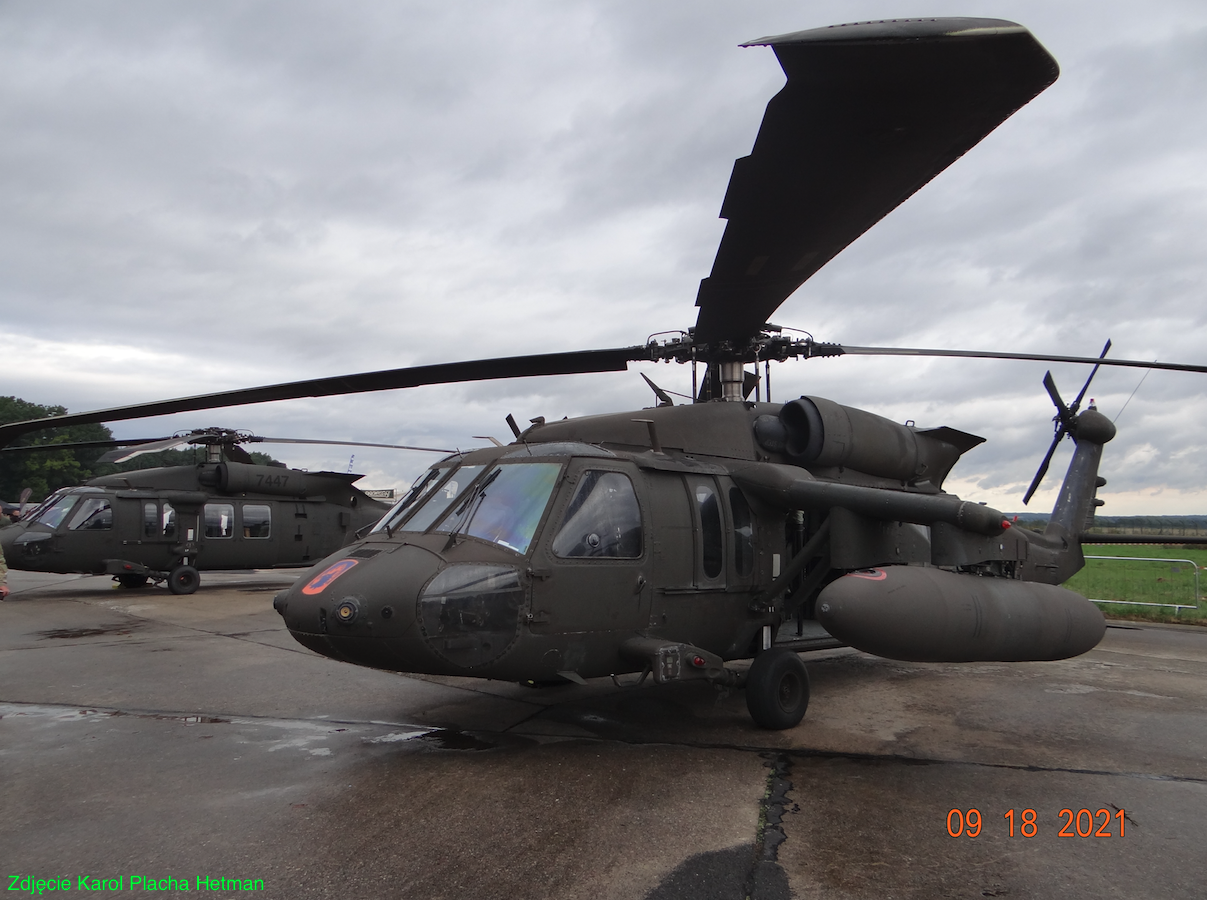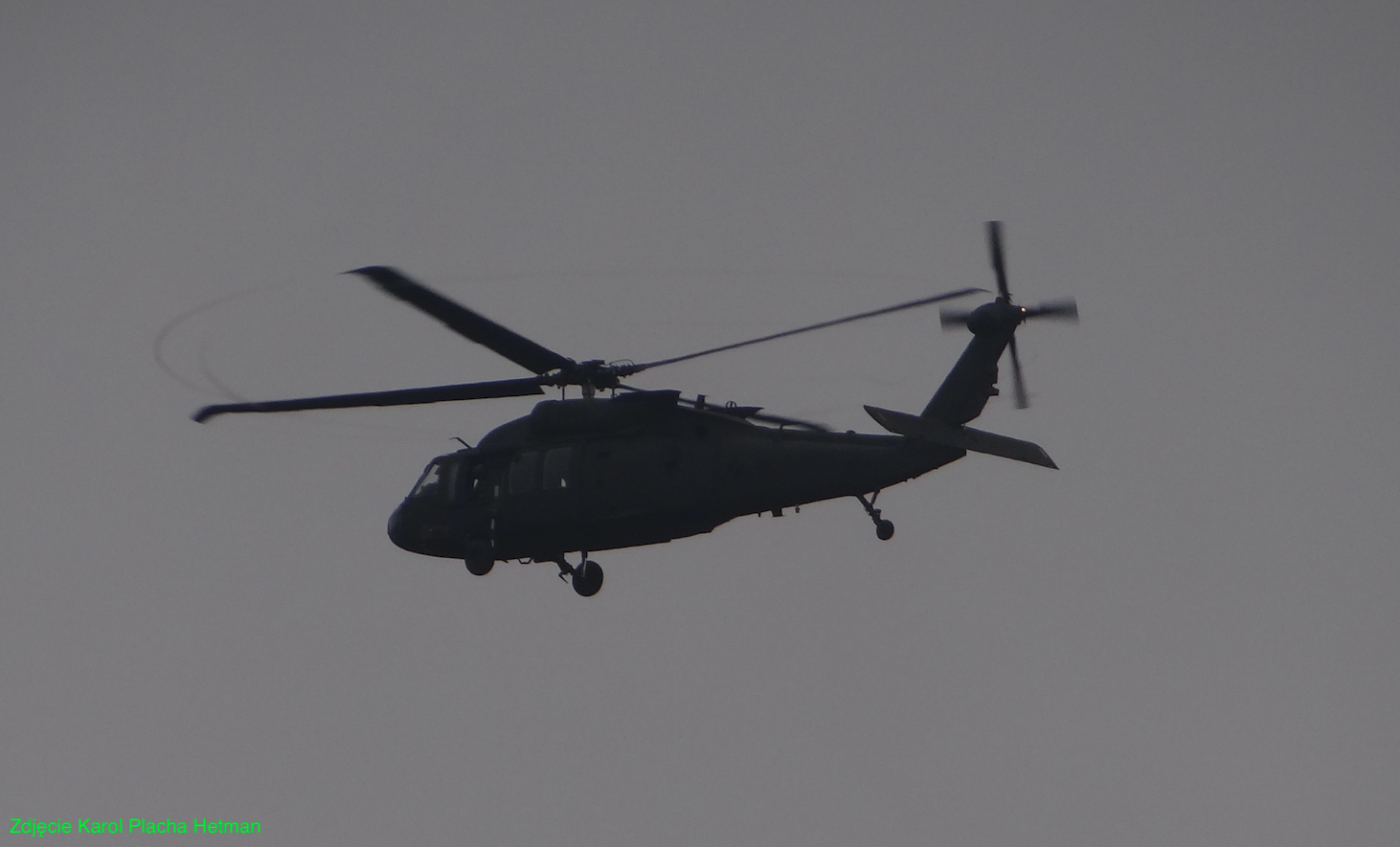Mielec 2012-04-19
Sikorsky-Mielec Black Hawk S-70i
317b Section 15.03.2010 year. Poland.
Construction S-70 / UH-60 Black Hawk.
The S-70 / UH-60 Black Hawk helicopter is built in the classic Sikorsky layout. The machine is a medium, twin-engine, all-metal, multi-role helicopter.
Fuselage.
The airframe is made of aluminum alloys with composites (glass and Kevlar laminates). The floor in the cockpit and hold is made of glass laminate and Nomex. Composites were also used in the tail boom. Such a beam is 10% lighter than a traditional one made entirely of metal.
The helicopter has been developed in terms of increased resistance to crushing during a fall. In impact with the ground at a vertical speed of 11.5 m/s and a horizontal speed of 12.2 m/s, the helicopter structure should retain 85%. It should withstand a horizontal acceleration of 20g and a vertical acceleration of 10g.
The crew seats are armored with Kevlar. The entrance to the cockpit is provided by car-type doors on the left and right sides, 1.37 m high. They can be shot off in an emergency. The hold takes 11-14 fully armed soldiers on board. After removing the middle seats, 4-6 pairs of stretchers or cargo can be mounted. The hold is heated and air-conditioned. Access to the hold is provided by large sliding doors on the port and starboard side, 1.75 m high. The helicopter can take on board a 105 mm howitzer, 50 rounds for it and a crew of 5 soldiers. The volume of the cockpit and hold is 10.90 cubic meters.
The ESSS external suspension system consists of a set of hooks permanently attached to the hull and four jibs mounted to them. The total load capacity of the external suspensions is 4,536 kg.
The vertical tail is the extended tip of the tail boom. Inside it there is an intermediate gear and a gear for the tail rotor located on the right side.
The horizontal tail has a large surface with a trapezoidal outline and a variable wedge angle. It has a large range of change; from +34 degrees (when hovering) to -6 degrees (when autorotation). Its control system takes into account the helicopter’s flight speed as well as pitch and lateral acceleration. The control is doubled electric and additionally manual, mechanical. Part of the tail boom is folded down for hangar to the right.
Three-support landing gear with a tail wheel. Constant. front, main with powerful shock absorbers from General Mechatronics. The pneumatics of the main landing gear wheels are 26×10.00-11, and the tail wheel 15×6.00. Main undercarriage spacing: 2.70 m. Undercarriage base: 8.83 m.
Support rotor.
Four-bladed rotor with rectangular outline and Sikorsky SC-1095 profile with a relative thickness of 9.5%. Rotor blade width: 0.53 m. The center section of the blade has a leading edge overhang and a trailing edge flap to overcome vortices from the previous blade in level flight. The turning angle of the blade is 18 degrees. 20 degree bevel blade tips. The blades have oval-section spars made of titanium. The trailing of the blades is made in a honeycomb system of nomex with an epoxygraphite composite coating. The base of the blade is also made of a glass fiber composite, additionally covered with a titanium cover. Blade tips are made of Kevlar. The shovel withstands penetration by a 23 mm caliber bullet. Inside, the blade is filled with pressurized gas and has sensors that tell about the durability of the structure. De-icing of the leading edge is carried out by means of an electrical system.
C/R Industries elastomeric rotor head bearings do not require lubrication. Vibration dampers are installed in the head. The head has been designed so that the rotor blades can be manually folded for easier hangaring or loading into a cargo plane. Rotor diameter: 16.36 m (53 ft 8 in).
Tail rotor.
Four-bladed tail rotor with a similar construction as the main rotor blades. Also electrically de-iced. It is located on the right side of the tail boom. It works as a pulling propeller. Its plane is inclined from the vertical to the left by an angle of 20 degrees. Thanks to this, it produces a small upward thrust, which makes it easier to balance the helicopter and allows for a greater wander of the center of gravity. Tail rotor diameter: 3.35 m.
Main gear.
Main gear in a conventional arrangement. Two turbine engines with a free turbine transmit power through planetary gears and a system of gears to the main shaft of the main rotor and to the drive shaft of the tail rotor. The main transmission has a structure consisting of five modules. It is possible to operate after a complete loss of oil for 30 minutes. The rotor head can be lowered down several centimeters for hangaring or transporting by plane.
Drive.
The drive unit consists of two General Electric T700-GE-700 turbine engines with a power of 2 x 1,151 kW. The civilian version of the engine is designated General Electric CT-7-2C. Their total power transmitted to the transmission is 2,109 kW. The newer version is the General Electric T700-GE-701 A with a starting power of 2 x 1,285 kW. Typical powerplant: 2 × General Electric T700-GE-701D turbocharger, 1,409 kW (1,940 hp).
Engine construction: 5-stage axial, 1-stage radial, annular combustion chamber, 2-stage turbine, free turbine. 5:1 static ratio, 4.5 kg/s airflow at 44,720 rpm. Free turbine with a rotational speed of 17,000 – 21,000 rpm. The motor is mainly made of AM-355 stainless steel. Dimensions 1.181m x 0.635m x 0.584m.
The engines are far away from each other, which makes it impossible to destroy both of them with one hit. In addition, they have fire partitions between them. The engines are capable of operating in extreme climatic conditions, high resistance to enemy fire, simple operation, small dimensions in relation to the power achieved. These engines are also used in AH-64 Apache combat helicopters.
Ring filters can be installed on the air inlets to capture 85% of air pollutants: sand and dust. APU – Solar T-62T-40-1 type. Starting system for Garret engines. An additional installation for starting engines in extremely low temperatures can be used.The fuel system consists of two tanks located behind the cargo hold with a total capacity of 1,340 litres. The tanks have high crush strength and are self-sealing. It is possible to install additional tanks in the cargo hold or on external booms.
Equipment.
24/28 V electrical installation. Bendix 30/40 kVA and 20/30 kVA power generators. Nickel-cadmium batteries with a capacity of 17 Ah. Fire protection system with fire extinguishers installed in the engine compartment and in the hull. Started automatically or manually.
Avionics (as of 1985).
Radio stations E-system AN/ARC-114 VHF-MF, Sylvania AN/ARC-114 UHF-AM, Magnavox AN/ARC-164 UHF-AM, Colins AN/ARC-186 VHF-AM/FM, transponder IFF Bendix AN/ APX-100, Magnovox TSEC/KT-28 radio communication secrecy system, intercom, Emerson AN/ARN-89 radio compass, Bendix AN/ARN-123 beacon receiver, Sperry AN/ASN-128 gyro compass, Honeywell AN/aPN radio altimeter -209, Melpar-Memcor AN/APR-39 radio warning receiver, Sanders AN/ALQ-144 infrared observation set, Hamilton Standard automatic flight control system with three-axis automatic pilot.
T-T Black Hawk S-70i data:
Crew two people. Capacity 14-17 seats / 12 soldiers / 6 stretchers. 4,072 kg (9,000 lb) payload. Length 19.76 m (64 ft 10 in). Fuselage length 15.26 m. Length with blades and tail boom folded 12.60 m. Fuselage width 2.36 m. Horizontal stabilizer span 4.38 m. Overall height 5.13 m. Rotor diameter 16.36 m (53 ft. 8 inches). Tail rotor diameter 3.35 m. Height 5.33 m (17 ft 6 in). Curb weight 5,347 kg (11,790 lb). Takeoff weight Maximum 9,979 kg (22,000 lb). Internal fuel 1,360 liters. Internal fuel tanks 2 x 700 liters, 1,705 liters (450 US gal) on deck and 872 liters (230 US gal) in tanks on each pylon or 1,705 liters (450 US gal). Maximum speed 361 km/h (195 knots, 224 mph). Cruise speed 163 knots (301.8 km/h), maximum cruise (149 knots, normal cruise). Range 463 km, (288 mi, 250 nm) with a reserve of 20 min. Usable ceiling 6,096 m (20,000 ft). Rate of climb 11.43 m/s (2,250 ft/m).
Standard armament.
Weapons: M240, MAG-58, M3M, Gau-19. Unguided missiles: Hydra. Guided Missiles: Hellfire (x16).
Written by Karol Placha Hetman


